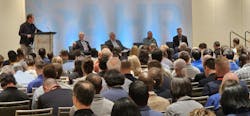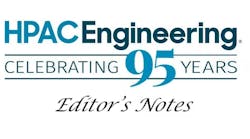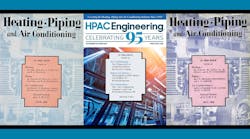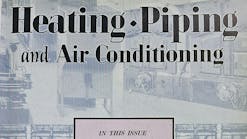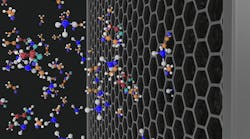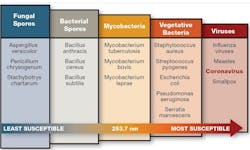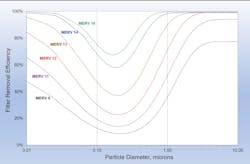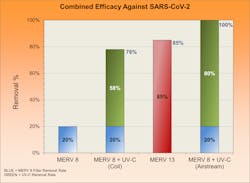Achieving MERV-13: UV-C Can Help Less Efficient HVAC Filters Get There
By WLADYSLAW KOWALSKI, PhD; DEAN SAPUTA and DANIEL JONES, UV Resources
Since the COVID-19 pandemic began, many of the recommended HVAC-oriented infection mitigation strategies have revolved around increased ventilation, increased filter efficiency, and ultraviolet energy, often in a layered approach.
To help prevent the airborne transmission of the SARS-CoV-2 virus, ASHRAE guidance –and by extension– the Centers for Disease Control and Prevention (CDC), starts with upgrading HVAC filters to at least a MERV 13 (Minimum Efficiency Reporting Value) rating.1
However, HVAC manufacturers and facility engineers are quick to caution that not all AHU systems –particularly the large number of aging systems– can handle the high airflow restrictions and static pressure of MERV 13 to HEPA filters. Fortunately, there is an easy-to-implement alternative for the millions of HVAC systems never intended to perform with MERV 13+ filters.
- In a hybrid solution, a MERV 8 filter combined with UV-C can yield up to a 78% single-pass removal/inactivation rate for SARS-CoV-2, which is near equal to the target performance recommended by ASHRAE
Through a hybrid approach, facility engineers can combine medium-efficiency filters (MERV 8) with ultraviolet germicidal irradiation (UVGI or shortwave energy in the ultraviolet-C spectrum) to yield near MERV 13-level efficiency rates without sacrificing airflow or compromising cooling capacity.
Complementing filter performance
Besides source control and increased ventilation, UVGI has been shown to complement filter operation. For example, marrying UV‑C lamps with filtration can increase the overall system's pathogen removal rate since the MERV 8 filter captures the larger pathogens, and the UV‑C inactivates the smaller, more susceptible pathogens.
For example, fungal and bacterial spores, which are less susceptible to UV-C, are typically large (1-10 microns or more) and are therefore more easily removed by a MERV 8 or higher filter.2 On the other hand, viruses and vegetative bacteria, which are smaller (0.1 - 1 microns), can penetrate filters and are often highly susceptible to UV-C. Therefore, combining filtration and UV-C systems offers an ideal solution to address the full complement of microorganisms found in indoor environments.
In fact, the ASHRAE Epidemic Task Force (ETF) endorses flexibility in meeting its standard: "Air-cleaning technologies can be combined to produce the desired MERV 13-equivalent level of air cleaning."3
UV-C doses are calculated by determining the amount of short-wavelength ultraviolet energy a microorganism receives or the germicidal "residence time." The dose or UV-C fluence is a function of UV-C intensity and the length of exposure time, typically expressed as Joules per square meter (J/m2).
HVAC UVGI air disinfection systems are commonly designed for a minimum of 0.25 seconds of UV‑C exposure (assuming airflow is 500 fpm with 24 in. of in-line depth). The higher the air velocity or shorter the in-line depth, the higher the UV‑C output (dosage) must be to achieve the desired inactivation rate.
The effectiveness of UV-C disinfection on various microorganisms has been well documented in the literature.4 It is reported as a microorganism-specific dose, at which 90% of the microorganism is inactivated (expressed as D90). The average D90 UV dose for airstreams with normal relative humidity is approximately 6 J/m2 for both viruses and vegetative bacteria, and the D90 UV dose for fungal spores is approximately 315 J/m2 at normal humidity levels.5 Note, the D90 rate for SARS-CoV-2 virus is 5.99 J/m2.6
HVAC Filter and Coil Efficiency
HVAC operators realize that while higher filter efficiency will reduce airborne pathogen levels, the increased resistance can generate unintended consequences. The combination of a higher efficiency filter, and loading of the filter with pollutants, can decrease overall air flow levels.
Similarly, as biofilm accumulates on and in cooling coils, airflow and heat transfer efficiency can be compromised. Both scenarios will not only lead to increased energy costs but, in all likelihood, a decrease in indoor air quality.
When confronted with increased system pressure, facility operators often attempt to compensate by boosting fan speeds. For many older HVAC systems, adjusting fan speed may not be possible or insufficient to deliver the desired airflow. The increase in pressure and fan speeds raise energy consumption, which compounds as more pollutants are captured, driving more pressure and requiring more frequent filter changes. Additionally, a conventional 20,000 CFM air handler will have 10 24-x-24-in. filters, and upgrading each from MERV 8 to MERV 13 will reflect a roughly 25% filter cost premium, along with increased labor and disposal fees.
Combining Air Cleaning Options
According to ASHRAE, the MERV 8 and UV-C pairing is not only less disruptive to existing HVAC equipment, but this combined approach can come near to the performance of a MERV 13-filter-only configuration.
Research has shown "that the particle size of the SARS-CoV-2 virus is around 0.1 µm (micrometer). However, the virus does not travel through the air by itself. Since COVID-19 is human-generated, the virus is trapped in respiratory droplets and droplet nuclei (dried respiratory droplets) that are predominantly 1 µm in size and larger."7 ASHRAE notes a MERV 13 and a MERV 8 filter are at least 85% and 20% effective, respectively, at capturing particles in the 1 µm to 3 µm (micrometer) size range, as reflected in Figure 2.8
Thus, the ASHRAE-recommended MERV 13 filters are significantly more efficient at capturing 1 µm to 3 µm particles than a typical MERV 8 filter.
Overall performance of air filters can be characterized by using the filter performance curves in Figure 2. The performance of UV-C systems can be characterized by the average UV dose imparted to the airstream. In this case, we evaluate the performance of the UV-C system against the SARS-CoV-2 coronavirus, which has a D90 dose of 5.99 J/m2.9
One indicator of airstream disinfection performance is a decrease in the concentration of airborne microbes. The rate of the decrease using a UV system could, for example, be compared to that achieved by ventilation with clean air alone, as opposed to recirculated air cleaning.
Figure 3 shows the average removal rates among three air cleaning scenarios:
- MERV 8-filter-only;
- MERV 8 filter combined with a typical UV-C cooling coil system producing a UV dose of 3.3 J/m2;
- MERV 13-filter-only.
The typical UV-C cooling coil system is designed to operate at 55 F and 500 fpm, and these conditions impose a 60% reduction of UV-C output due to windchill effects (cold air reduces the output of UV-C lamps) and a 15% lamp lifetime depreciation calculation, which makes this a conservative calculation. The UV-C inactivation rate is based on the SARS-CoV-2 virus published diameter of 0.113 µm and UV rate constant per Walker.10
The results shown in Figure 3 illustrate the fact that combining UV-C with a MERV 8 filter can yield near equal MERV 13 removal rates, and an increase in the germicidal dose (increase in lamps) can offer even stronger performance. Importantly, as noted above, this combination of air cleaning technologies can also provide energy savings due to the lower pressure losses associated with the MERV 8 filter.
Another means of checking this "hybrid" premise is to consider how many outdoor air changes per hour (ACH) are needed to reduce airborne particles at a level comparable to a MERV 13 filter. ASHRAE has developed a calculator11 to determine the number of air changes of equivalent outdoor air, using a combination of air cleaning options.
Using this calculator (found on the Filtration and Disinfection webpage of the ASHRAE Building Readiness Guide), Figure 4 demonstrates that the MERV 8 + UV-C combination yields nearly identical air change equivalency rates per hour (ACH_e) without the aforementioned energy penalties to compensate for increased MERV 13 air resistance.
Most commercial HVAC systems are limited by the amount of outside air they can draw and the significant energy costs associated with conditioning additional outside air. Therefore, many facility managers turn to filtering recirculated air and raising equivalent air changes per hour (ACH_e).
HVAC Energy Savings
The energy savings that result from pairing medium-efficiency MERV 8 filters with UV-C germicidal energy are two-fold.
The first tier of savings is relatively straightforward. Since a MERV 8 filter generates less static pressure than a MERV 13 filter, there is less airflow resistance so that fan speed, and the energy required to operate the fan, can be reduced. Said differently, the higher the pressure drop, the more energy it takes to move air through the filter.
Apart from the fact that some HVAC systems cannot drive enough air through a MERV 13 filter to meet demand, those that are capable will expend more energy to compensate for the increased resistance.
As evaporator coils remove heat and moisture from the air, the corresponding condensation produced can lead to biofilm, which acts as a "glue" for dust and other airborne particulates to build up on the coil. The captured particulate provides a great food source for microbial proliferation, as does the moist and dark conditions inside an air handler. Biofilms may also develop in drain pans and foster the further growth of microbial contaminants.
So thus, the second level of savings comes with the addition of UV-C energy applied downstream of the cooling coil. The 253.7 nm germicidal wavelength will destroy biofilm, bacteria, and mold that settle and proliferate on HVAC coils, which, left untreated, will cause an increase in pressure drop, reduced airflow and a decrease in heat transfer efficiency.
As the coil fins become packed with additional contaminants, pressure drop across the coil increases and less heat can be removed from the air due to the layer(s) of biofilm and contaminants; the entire system must work harder to overcome this loss in cooling capacity.
As demonstrated in ASHRAE Research Project 173812 , UV-C energy continuously destroys coil/drain pan microbial infestations. The study found that the use of a UV-C coil-irradiation system reduced pressure drop an average of 21%, while increasing heat transfer efficiency by 14%. Moreover, UV-C ensures that the velocity of the air between coil fins (interstitially) is optimized, while fin surfaces are kept clean to maximize system heat-exchange efficiency and heat transfer rate.
Physical Space Limitations
A sizable portion of existing AHUs are fitted with one- or two-inch air filters and cannot physically accommodate a true MERV 13 four-inch mechanical filter. With limited space options, some facility engineers turn to electrostatically enhanced MERV 13 filters.
Electrostatic air filters use charged media to increase particle attraction. Unfortunately, the static charges responsible for this attraction diminish over time, and to such an extent that the performance of a MERV 13 electrostatic filter may decrease to a lower MERV efficiency rate within weeks after installation. According to ASHRAE's 52.2 standard, electrostatic air filters "may demonstrate high efficiency when clean, and a drop in efficiency during their actual use cycle."13
While a two-inch MERV 13 electrostatically enhanced filter may physically fit into an AHU, filter performance may not yield the designated removal rate, compromising your facilities' ability to remove airborne pathogens, especially those that are less than 1-3 microns in size.
Conversely, true MERV 13 mechanical filters increase their effectiveness over time as air particles are trapped onto the filter media, thereby narrowing pathways for future air to pass. In other words, particle reduction efficiency improves as the filter loads up, leading to additional filter change-outs.
Conclusion
The use of UV-C for air disinfection has been shown to significantly reduce respiratory symptoms in office buildings and to lower contact infections by 40% in a hospital.14 Removing bacteria from the air with UV-C at the room level has been shown to significantly reduce infection rates in a hospital.15
As evidence accumulates for the airborne spread of SARS-CoV-2 coronavirus and increased demand for better indoor air quality across all building types grows, air disinfection technologies are inevitable. In a hybrid solution, a MERV 8 filter combined with a medium dose of UV-C can yield up to a 78% single-pass removal/inactivation rate for SARS-CoV-2, which is near equal to the target performance recommended by ASHRAE.
Societies such as ASTM, ASHRAE, and IUVA have begun addressing solutions for the problem of airborne disease transmission, and much of this focus revolves around the use of filtration and UV-C. New guidelines and standards under development by these organizations will assure proper design, testing, and installation of UV-C systems and pave the way for widespread use, which may, in turn, reduce the risk of airborne disease transmission in indoor environments.
#########
ABOUT THE AUTHORS
Wladyslaw Kowalski, PhD. Dr. Kowalski has worked as a UV researcher at Penn State University, served as president of the Air Treatment Group of the International Ultraviolet Association (IUVA), and is a subject matter expert for NASA, ASTM and ASHRAE. Contact: [email protected]
Daniel Jones. President and Co-Founder of UV Resources, Jones is a corresponding member of ASHRAE TC 2.9, Ultraviolet Air and Surface Treatment, and the standard project committee for ANSI/ASHRAE Standard 185.2. Contact: [email protected]
Dean Saputa. Vice President and Co-Founder of UV Resources, Saputa, currently serves as Chair of ASHRAE SPC-185.2 (Method of Testing Ultraviolet Lamps and as Secretary of GPC-37, Guidelines for the Application of Upper-Air Ultraviolet Germicidal Devices to Control the Transmission of Airborne Pathogens. Contact: [email protected]
##########
REFERENCES
1 ASHRAE. ASHRAE Technical Resources; Filtration and Disinfection FAQ. Retrieved from https://www.ashrae.org/technical-resources/filtration-and-disinfection-faq;
2 Kowalski, Wladyslaw. (2009). Ultraviolet Germicidal Irradiation Handbook. Retrieved from https://download.e-bookshelf.de/download/0000/0138/90/L-G-0000013890-0002346490.pdf;
3 ASHRAE Epidemic Task Force Available Resources (Online 2021) Filtration/Disinfection. Retrieved from https://www.ashrae.org/technical-resources/filtration-disinfection;
4 IBID., 2;
5 IBID., 2.
6 Walker CM, Ko G. 2007. Effect of ultraviolet germicidal irradiation on viral aerosols. Environmental Science & Technology 41(15):5460–5465 DOI 10.1021/es070056u. Retrieved from https://pubmed.ncbi.nlm.nih.gov/17822117/
7 ASHRAE Technical Resources, Filtration and Disinfection FAQ. Retrieved from https://www.ashrae.org/file%20library/technical%20resources/covid-19/filtration-and-disinfection-faq.pdf
8 IBID., 2;
9 IBID., 6;
10 IBID., 8;
11 ASHRAE Air Change Equivalency Calculator (January 2021). ASHRAE Epidemic Task Force's Building Readiness Guide. Retrieved from https://docs.google.com/spreadsheets/d/1GUCcjAyhzrTATHD8SQvNcF7JnuWKpadSVT6LA_8SUII/edit
12 Joseph Firrantello, William Bahnfleth & Paul Kremer (2018) Field measurement and modeling of UVC cooling coil irradiation for heating, ventilating, and air conditioning energy use reduction (RP-1738)—Part 1: Field measurements, Science and Technology for the Built Environment. Retrieved from https://www.tandfonline.com/action/showCitFormats?doi=10.1080%2F23744731.2017.1402662
13 ASHRAE (2017) Method of Testing General Ventilation Air-Cleaning Devices for Removal Efficiency by Particle Size. ANSI/ASHRAE Standard 52.2-2017. Retrieved from https://www.ashrae.org/File%20Library/Technical%20Resources/COVID-19/52_2_2017_COVID-19_20200401.pdf
14 Menzies D, Popa J, Hanley JA, Rand T, Milton DK. (2003). Effect of ultraviolet germicidal lights installed in office ventilation systems on workers' health and wellbeing: double-blind multiple crossover trials. The Lancet. Retrieved from https://www.thelancet.com/journals/lancet/article/PIIS0140-6736(03)14897-0/fulltext
15 Ethington T, Newsome S, Waugh J, Lee LD. (2018). Cleaning the air with ultraviolet germicidal irradiation lessened contact infections in a long-term acute care hospital. Am J Infect Control. Retrieved from https://www.researchgate.net/publication/322128363_Cleaning_the_air_with_ultraviolet_germicidal_irradiation_lessened_contact_infections_in_a_long-term_acute_care_hospital
##########
